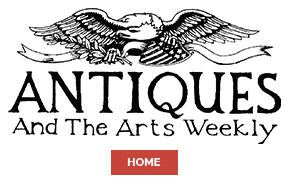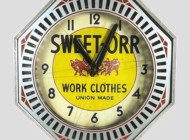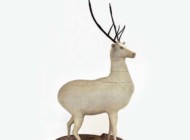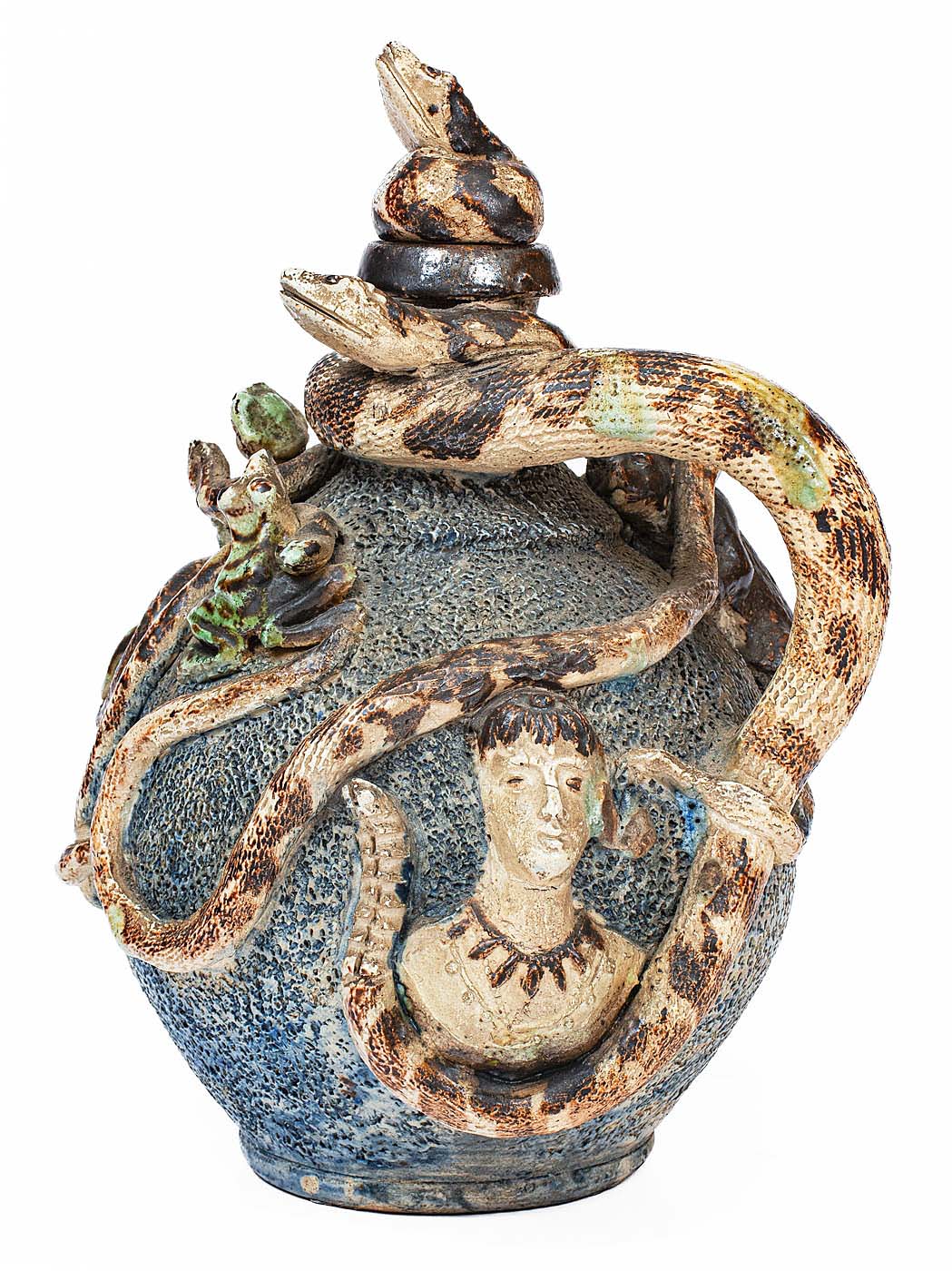
This salt-glazed stoneware temperance jug by the Anna Pottery, Anna, Ill., circa 1880, stood 12 inches high and came with extensive provenance and exhibition history, and no excuses for condition. Estimated at $30/50,000, an advanced folk art collector topped it off at $144,000, the highest price of the day.
Review by Madelia Hickman Ring
SPARKS, MD. — The 390-lot sale Crocker Farm held April 2-11, with the final phone bidding session on Saturday, April 12, resulted in all lots selling and an aggregate total of $972,930. Mark Zipp said he and his family were very pleased with the sale, noting in particular a strong per-lot average of about $2,500.
The first lot of the day was anticipated to bring the most money and it did: $144,000 against a $30/50,000 estimate. Earning its place at the head of the sale — and a new world auction record for a snake jug from the Anna Pottery — was a salt-glazed stoneware temperance jug made by the Anna Pottery in Anna, Ill., around 1880. Zipp, asserting he’d classify “all temperance jugs as rare,” drew our attention to a few things that made this example particularly special: it had “an incredible application of cobalt slip glazing that was very striking,” a bear and Native American figure in addition to the usual decorative motifs of snakes and frogs, great condition and provenance to not only the Kirkpatrick family that owned the pottery but the collections of Nancy and Gary Stass and George H. and Kay White Meyer, who published it in their book, Early American Face Jugs (2019). An advanced folk art collector won the piece.
A second Anna Pottery temperance jug that also came from the Meyers’ collection followed across the block and was considered a masterwork but was not in as-good condition. It sold to ceramics scholar and advisor, Rob Hunter, for $25,200. Zipp noted the losses to the applied decoration were “typical of the form.”
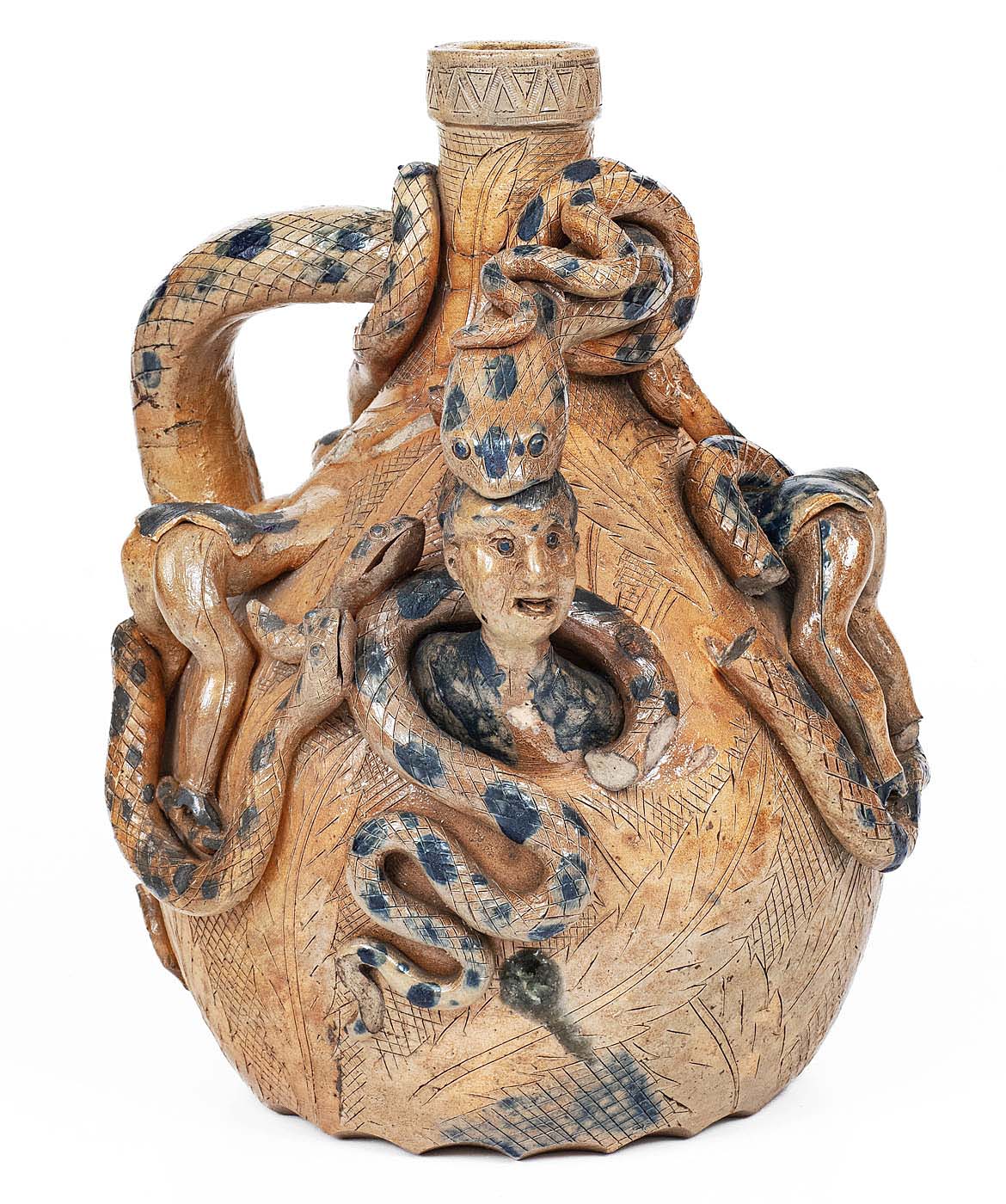
Snake-decorated temperance jugs often feature losses to their decoration; such was the fate of this signed Anna Pottery stoneware jug that had provenance to the Meyers collection. The 10½-inch-piece sold to ceramics scholar Rob Hunter for $25,200 ($20/30,000).
Hunter was successful in purchasing a couple of other lots in the sale. One was a rare American redware open-handled jar with vibrant slip decoration that related to examples found in Charlestown, Mass., and Philadelphia ($5,400). But the piece he really wanted, and what he considered “one of the most important objects in the sale,” was a third-quarter Southern stoneware jar with elaborate iron-slip tree that had recently been discovered in Alabama and catalogued as “probably Texas, possibly Guadalupe County” ($9,600).
The second-highest price of $45,000 was realized by two pieces, one of which was a circa 1815 stoneware pitcher with elaborate incised bird and floral designs attributed to Baltimore potter, Henry Remmey, Sr. Zipp confirmed it was a “previously unknown piece” and appealed most to an advanced folk art collector.
The other lot to bring $45,000 was a six-gallon stoneware presentation churn, made at the John Park Alexander Pottery in Akron, Ohio, that was elaborately decorated with a grouse with a banner. Published in Robert F. Treichler’s 2011 book, A History of Northeast Ohio Stoneware, and described in the catalog as “among the finest examples of Ohio stoneware that we have ever offered,” it found a new home with another advanced folk art collector.
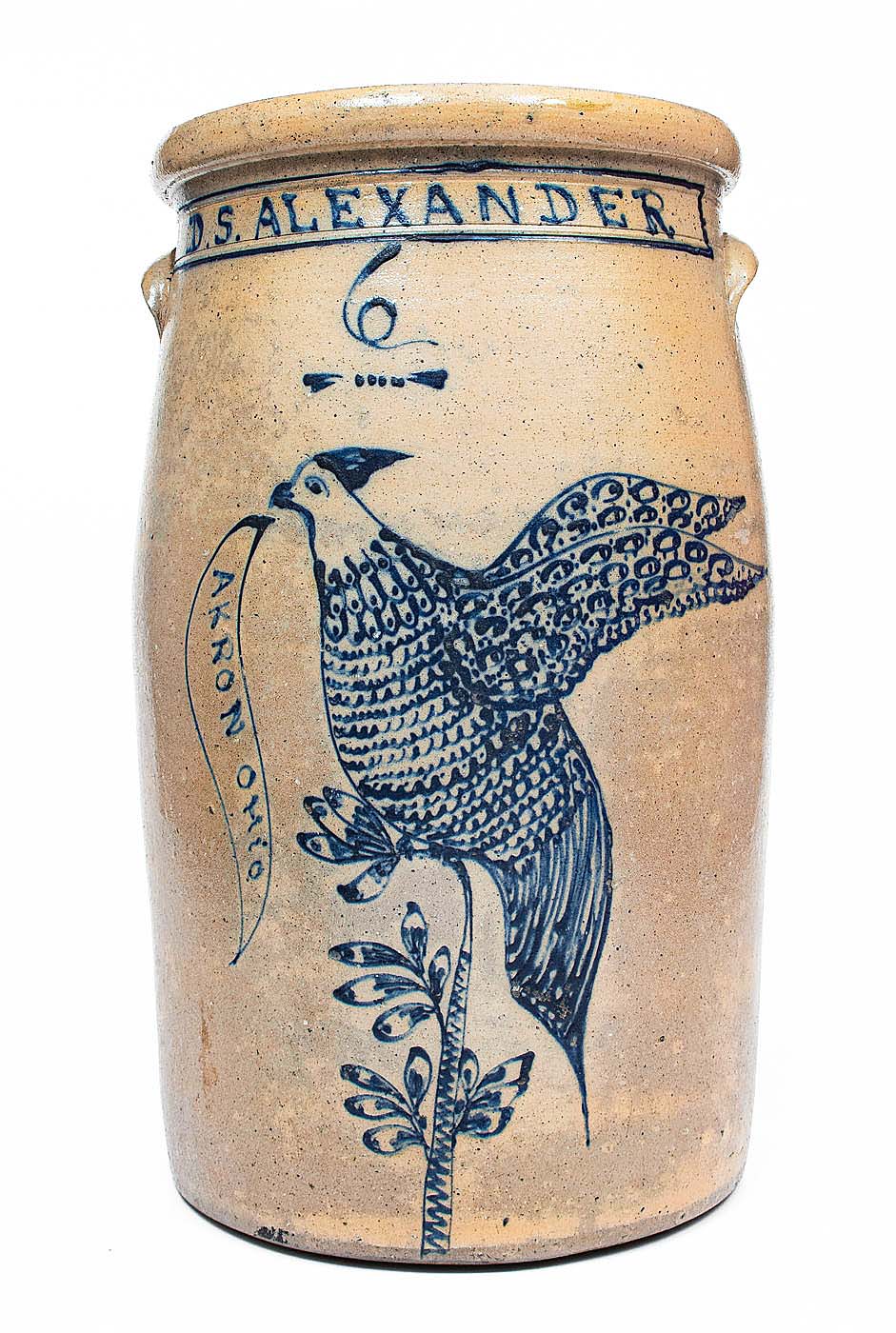
Mark Zipp noted that the churn form — tall straight sides — lent itself to bold, large-scale decoration. This six-gallon example, made around 1870 in Akron, Ohio, at the John Park Alexander Pottery, was boldly decorated with a grouse with banner and finished at $45,000 ($20/40,000).
Churn collectors who missed out on the Akron example had 11 other lots to pursue. The next priciest version of the form came with a 20½-inch-tall example made by J. Burger, Jr, of Rochester, N.Y., that featured a cat — different from the maker’s quintessential lion design — finding a new home in New York City, for $18,000.
If bold decoration was the draw for the Northeast and Midwestern potters and pottery collectors, a more minimalist aesthetic is what collectors of Southern pottery are looking for, where nuances of glaze application, form and size are the deciding factors. Topping the sale’s offerings of Southern pottery was an “outstanding” 10-gallon stoneware jug made by Daniel Seagle in Vale, Lincoln County, N.C., that realized $36,000 and a new world auction record for the potter. A folk art collector in North Carolina had the prevailing bid.
Another record set in the sale was also $36,000, for a pair of sewer tile lion statues, probably made in Ohio, that dated to the late Nineteenth Century. Once part of the personal collection of Connecticut dealer, Peter Tillou; the pair demonstrated “extraordinary size, outstanding subject matter and a highly appealing folk art aesthetic.” In short, the pair was “the finest lot of sewer tile Crocker Farm has ever offered.”
Seven face jugs were in the sale and sold for a variety of prices, from $1,020 for a 9½-inch tall circa 1985 Lanier Meaders example to $28,800 for a dated 1901 salt-glazed jug attributed to the John A. Roberts Pottery in Cookeville, Tenn. Crocker Farm set a record ($90,000) for a face jug by the potter in its January 31 sale of the Carole Wahler collection; whereas the record-holding jug sold to a folk art collector, the one in this sale found a new home in Tennessee, with a collector of Tenneessee pottery.
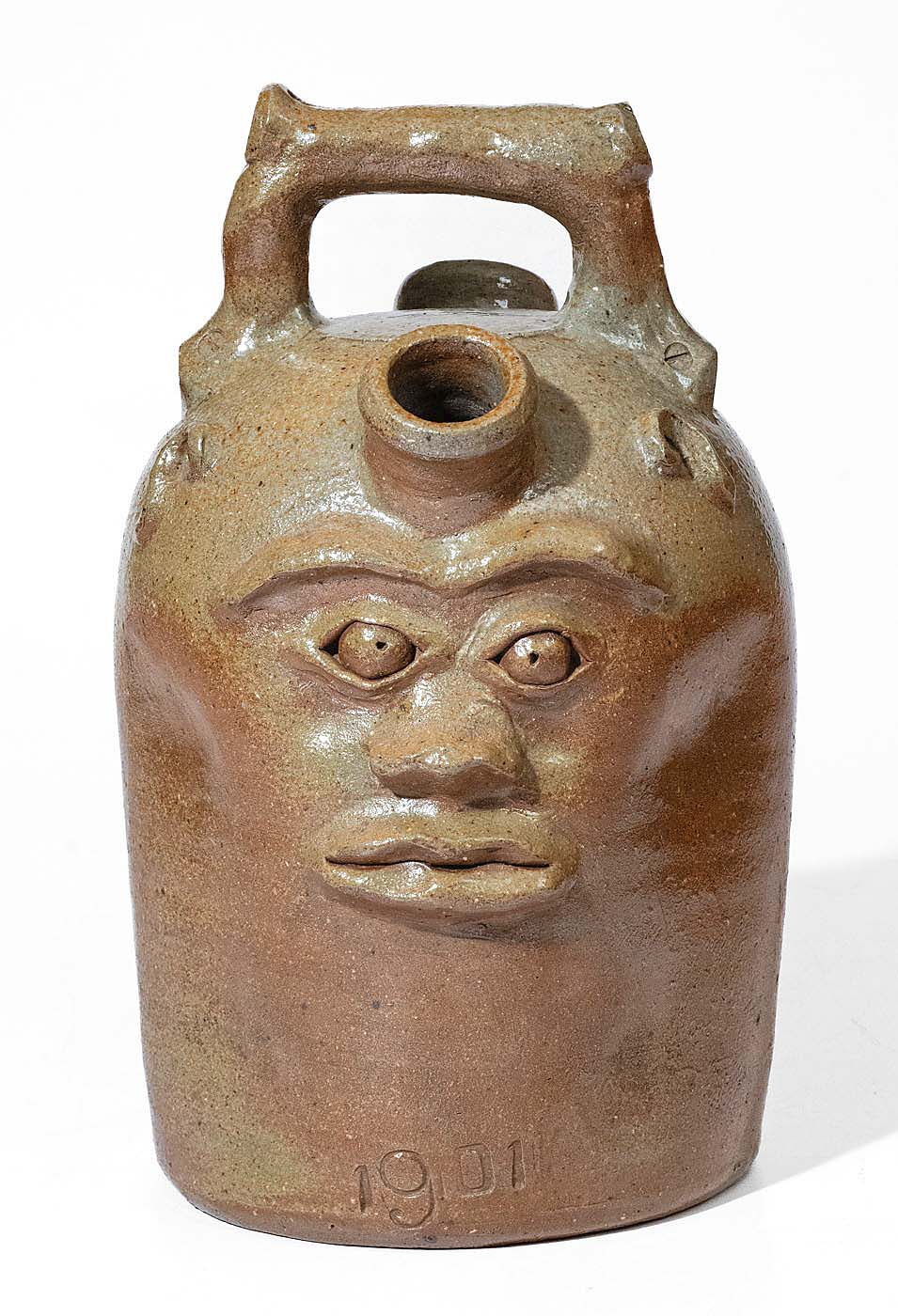
Crocker Farm set a record for Tennessee stoneware in January so interest in this face jug was high. This J.A. Roberts’ face jug, dated 1901, sold to a Tennessee pottery collector for $28,800 ($15/30,000).
Pottery from central Pennsylvania — Harrisburg in particular — is another niche of the market that is enjoying strong interest; Zipp attributed this to both some new buyers as well as an invigorated group of long-time collectors. Leading pieces from this region was a two-gallon jar with a house depicted in cobalt decoration that was made by Cowden & Wilcox, circa 1865. The Zipps knew of only one other house-decorated piece by Cowden & Wilcox, who they characterized as “Central Pennsylvania’s most collected Nineteenth Century stoneware manufacturer.” A bidder from Pennsylvania won it for $22,800.
An early Nineteenth Century New York State redware jar with copper decoration, newly discovered in North Carolina, was remarkable not least for its brilliant glaze but for the survival of its original domed cover. A Northeastern buyer topped it off at $20,400.
Big prices were achieved for not only big pieces but for smaller ones as well. Case in point: a miniature stoneware jar, made by Chester Webster of Randolph County, N.C., which Mark Zipp recognized for its extensive incised decoration and fabulous condition. It will be returning to the state it was made in, to a collector who ran it to $14,400.
Crocker Farm’s next sale will take place in August.
Prices quoted include the buyer’s premium as reported by the auction house. For information, info@crockerfarm.com, 410-472-2016 or www.crockerfarm.com.
